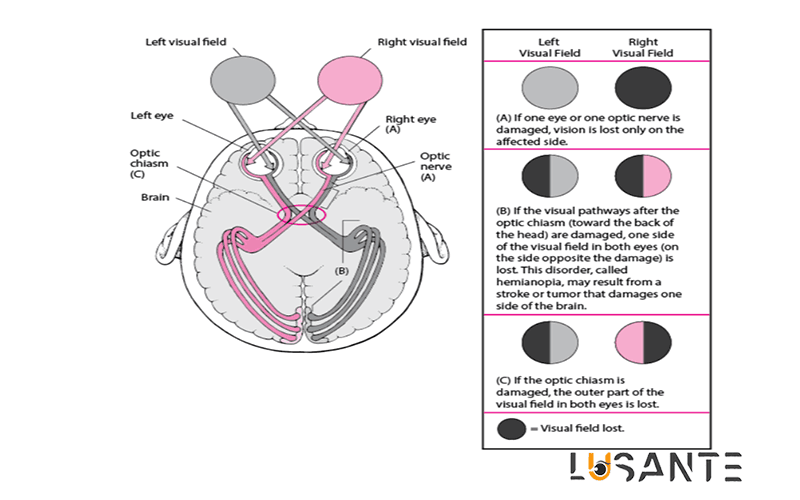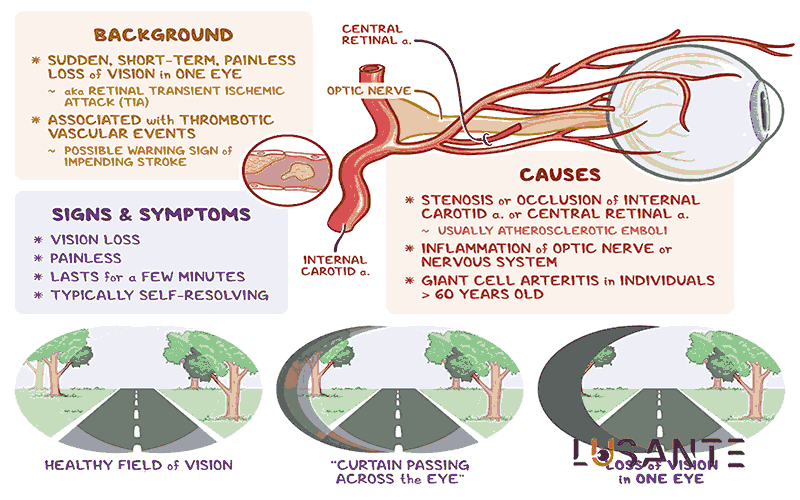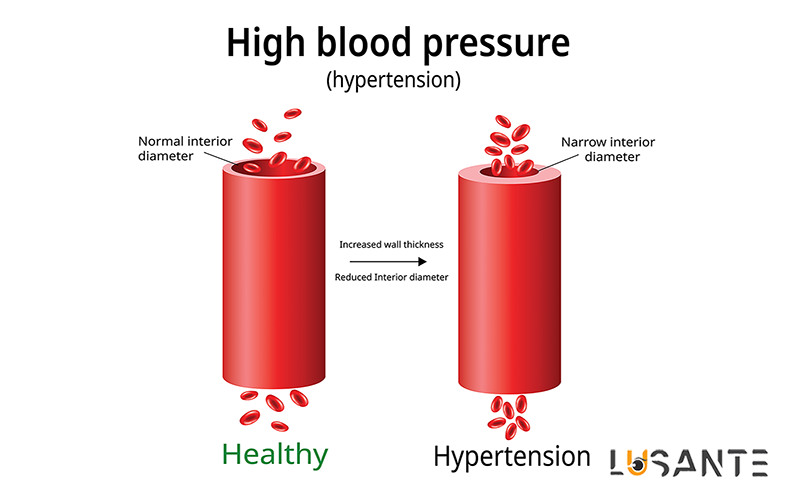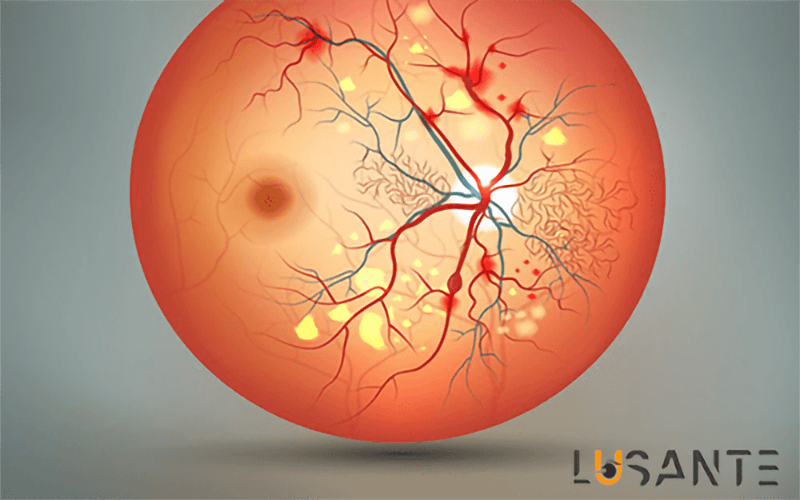Peripheral Vision Loss and Tunnel Vision
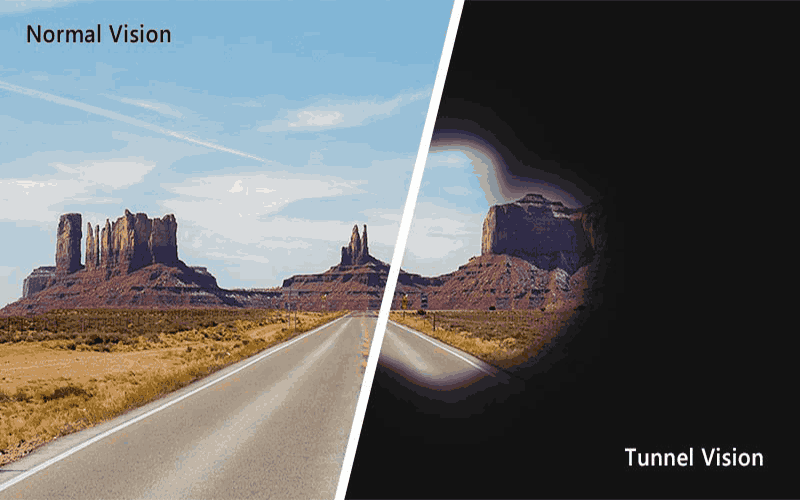
Tunnel vision or Peripheral Vision Loss (PVL) is the result of losing the surrounding visual field or lateral vision. Individuals with tunnel vision can only see what is directly in front of them. This condition can occur due to eye diseases or other health conditions that affect vision.
What is Peripheral Vision Loss (PVL)?
Tunnel vision or Peripheral Vision Loss, which is the vision that lies outside of a person’s direct vision.
This means that the eyes can only see clearly what is in front of them, but may have gaps in side vision. This condition can be temporary or permanent depending on the underlying cause.
Symptoms of tunnel vision
Individuals may notice that the outer edges of their vision are blurry or darkened, while the central vision remains clear. Those severely affected by PVL may describe it as looking into a tunnel, hence the term “tunnel vision or Peripheral Vision Loss“.
Depending on the underlying cause, individuals may experience symptoms of tunnel vision in one or both eyes.
They may also notice the following symptoms related to tunnel vision:
- Difficulty with orientation in a crowd.
- Bumping into objects.
- Falling
Other symptoms are dependent on the cause of Peripheral Vision Loss.
In the following, we will further explore possible causes in more detail.
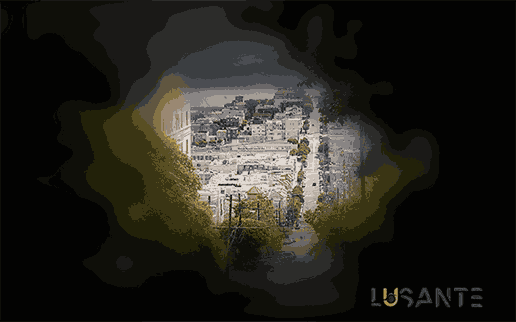
Causes of tunnel vision
-
Symptoms of Peripheral Vision Loss; Migraine
Migraine is a common neurological disorder that causes severe headache and may last for several hours, or even days. It often involves a throbbing pain on one side of the head and is typically accompanied by nausea.
Other symptoms of Peripheral Vision Loss may include vomiting, sensitivity to light, smell, or sound, dizziness, visual disturbances, and tingling or numbness in the face, hands, or feet.
It is likely that you have also raised the question of the cause of migraines. It is important to note that the exact primary cause has not been definitively established, but in the recognized symptoms of a migraine attack, some doctors believe that the brains of individuals with migraines react more intensely to environmental stimuli such as stress or sleep disturbances compared to those who do not have this condition.
What are the symptoms of a migraine headache?
One of the questions raised by patients is about the signs or symptoms of a migraine. The symptoms of this condition can vary depending on its type and the individual. Generally, a migraine attack is very painful and can disrupt your daily life.
One of the most common symptoms of a migraine is a headache, often described as a severe throbbing sensation. It usually occurs on one side of the head, but sometimes it can affect both sides, and in some cases, it starts on one side and moves to the other.
Common Symptoms of Migraine
In general, these are the common symptoms of a migraine:
- Light sensitivity, where a dark environment during attacks may help.
- Sound sensitivity, which can make normal noises unbearable.
- Sensitivity to touch or experiencing pain from gentle touches, such as brushing teeth, combing hair, or touching the face with a pillow.
- Nausea and vomiting.
- Throbbing headache.
- Neck pain or stiffness.
- Fatigue
- Difficulty concentrating.
- Dizziness
- Depression or anxiety.
- Ringing in the ears.
- Sinus pain.
- Diarrhea
- Aversion to certain smells.

How is the diagnosis of migraine conducted?
There is no single test that can definitively diagnose migraine. Instead, the doctor evaluates your condition, takes your family history into account, and may recommend specific blood tests and imaging to rule out other causes of headaches. It is important to provide a detailed report of your symptoms to assist with the diagnosis.
What causes migraine attacks?
The exact cause of migraine attacks remains unknown. Research indicates that both genetic and environmental factors may play a role. There can be numerous triggering factors and causes for migraine attacks, including:
- Hormonal changes
- Certain beverages
- Specific foods
- Stress
- Medications
- Physical factors
- Sensory stimuli
Consulting with a specialized physician is recommended for accurate diagnosis and optimal management of migraines.
Is there an effective treatment for migraine attacks?
Treatment for migraines can help prevent attacks. Sometimes, lifestyle changes alone can provide relief from this condition, but in other cases, medical intervention and diagnosis may be necessary for improvement.
Medical treatment and lifestyle adjustments can work together to alleviate this condition. Some lifestyle changes can help reduce the frequency and severity of migraine attacks, such as:
- Getting sufficient and quality sleep
- Reducing stress
- Drinking an adequate amount of water
- Engaging in regular light exercise
- Reducing gluten consumption
Researchers and specialized physicians are working to identify the root causes of migraine headaches. Depending on the type of migraine and the intensity of symptoms, a neurologist may recommend the following:
- Migraine medications for prevention
- Botox or Dysport injections
- Therapeutic massage
- Therapeutic injections
- Acupuncture
- Nerve blocks
Your doctor may also provide you with tips to help reduce migraine attacks. With appropriate treatment, you can reduce the frequency or minimize the intensity of your migraines.

- Peripheral Vision Loss; Pigmentary Retinopathy or Retinitis Pigmentosa
Retinitis Pigmentosa, also known as Inflammatory Retinopathy, refers to a group of eye conditions that affect the retina. This condition alters the way the retina responds to light, leading to visual problems. Individuals with Retinitis Pigmentosa will gradually lose their vision over time. However, it typically does not result in complete blindness for these individuals.
Retinitis Pigmentosa (RP) is a term used to describe a group of eye diseases that cause a loss of visual ability and a reduction in vision. When someone has RP, the cells in the retina, also known as photoreceptors, do not function properly, and over time, their vision will deteriorate.
According to the American Academy of Ophthalmology (AAO), Retinitis Pigmentosa alters the way the retina responds to light, which can make vision challenging for individuals.
Alongside gradual loss of peripheral vision, other symptoms
- Night blindness: This means individuals have difficulty seeing objects in the dark. Their vision may be normal during the day but require more time to adjust to darkness. Additionally, their visual acuity in low light may be reduced.
- Loss of central vision: Individuals may also experience difficulties in their central vision.
- Difficulty in color vision: They may have trouble distinguishing colors.
Prevalence of Retinitis Pigmentosa
This condition is a rare genetic disorder that is inherited from parents to children. According to statistics, only one in every 4,000 individuals is affected by Retinitis Pigmentosa. Nearly half of the individuals with Retinitis Pigmentosa have a family member with this eye condition.
Structure of the Retina
The retina of the eye has two types of cells for gathering light from the surroundings and enabling vision:
- Rod cells:
These cells are located around the outer ring of the retina and continue to function in low light conditions. Most types of Retinitis Pigmentosa initially affect the rod cells of the eye. As a result, the first symptoms after being affected by Retinitis Pigmentosa will be a loss of the ability to see in dim light and during the night.
- Cone cells:
Cone cells are located in the central part of the eye. These cells help with color detection and greater detail perception.
Therefore, when Retinitis Pigmentosa affects the cone cells, the individual will gradually lose the ability to perceive colors and have difficulty in recognizing details.
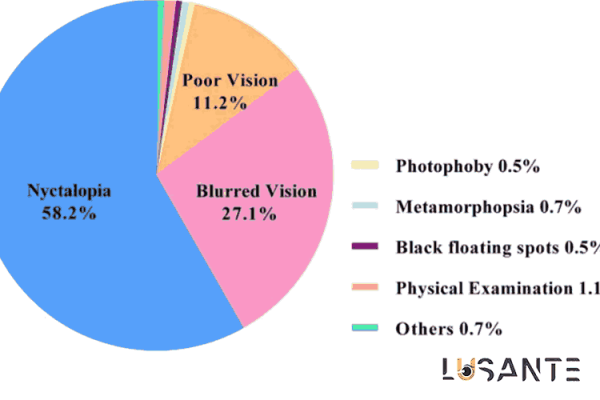
Peripheral Vision Loss and Tunnel Vision: Causes of Retinitis Pigmentosa
Retinitis Pigmentosa is a rare genetic disease that is inherited from parents to children. The speed and type of vision loss after being affected by Retinitis Pigmentosa are not uniform and vary from one individual to another. This variation depends on the type of the disease as well. More than 60 different genes can cause various types of Retinitis Pigmentosa.
Peripheral Vision Loss and Tunnel Vision: Symptoms of Retinitis Pigmentosa
Retinitis Pigmentosa usually begins in childhood, but the age of onset and the rate of progression can vary from person to person. Many individuals with Retinitis Pigmentosa lose a significant portion of their vision by the time they reach adolescence and adulthood, and most of them experience legal blindness by the age of 40.
Early Stages
In the initial stages of this eye condition, the rod cells are affected. As a result, individuals may have difficulty seeing in low light conditions and may take more time to adjust to darkness. For example, a person with Retinitis Pigmentosa may face difficulties when walking from a bright environment to a dark theater. They may have trouble driving at night or constantly need to rely on touching objects with their feet when passing by them.
Progressive Stage
As the disease progresses, in addition to night vision problems, individuals will lose their peripheral vision, and their visual field will resemble a tunnel. To see objects at the sides of their visual field, they may have to turn their head to place the objects in the center of their visual field.
Advanced Stages
The cone cells are affected, and individuals may have difficulty distinguishing colors. Additionally, they may struggle to perform detailed tasks or even read.
However, it’s important to note that the progression of Retinitis Pigmentosa is not always the same, and in some rare cases, individuals may lose cone cells in the early stages.
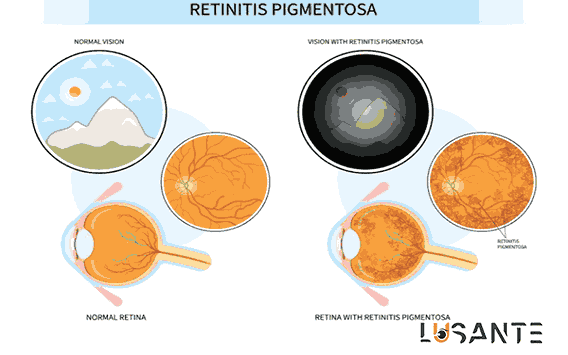
Complications of retinitis pigmentosa may include
- Night blindness: After the onset of this condition, your daytime vision remains unaffected, but you may experience significant difficulties with your night vision.
As the disease progresses, adapting to darkness becomes increasingly challenging, and it may take longer for you to adjust to dimly lit environments.
Eventually, you may find it difficult to drive after dusk or enjoy watching movies in theaters or cinemas.
- Gradual loss of peripheral vision: This condition is commonly referred to as “tunnel vision.” As the disease advances, your ability to see objects in your peripheral visual field diminishes, and your vision becomes narrowed, similar to looking through a tunnel. Consequently, you will need to turn your head to see objects on the sides and under your feet, and you will constantly need to look down to navigate.
- Difficulty with color recognition: Some individuals with retinitis pigmentosa may experience challenges in recognizing certain specific colors, and this difficulty may worsen over time.
Diagnosing Retinitis Pigmentosa
An ophthalmologist is capable of diagnosing Retinitis Pigmentosa and can make you aware of this condition through an examination and a series of tests.
Some possible diagnostic tests include:
- Ophthalmoscope
To perform this test, the doctor will put a few drops into your eyes.
These drops help dilate your pupils, allowing the ophthalmologist to have a closer look at your retina. Then, using a special instrument, the doctor will examine the back of your eye, and if the person is affected by RP, the doctor will notice spots and black dots on the retina.
- Visual Field Test
To perform this visual test, a device is likely used that displays objects and lights at the periphery of your vision. If you see them, you’ll press a button on the device. At the end of the test, the device will show you the range of your peripheral vision.
- Electroretinogram (ERG)
The doctor will place a piece of gold foil or special lenses on your eyes to measure the retina’s response to light.
- Genetic Testing
This requires a DNA test. The patient with suspected Retinitis Pigmentosa needs to undergo DNA testing.
- Optical Coherence Tomography (OCT)
OCT is an imaging technique that takes high-quality images and detailed views of the retinal layer of the eye.
This procedure helps with accurate diagnosis of RP and determines the extent of retinal involvement in the person’s eyes.
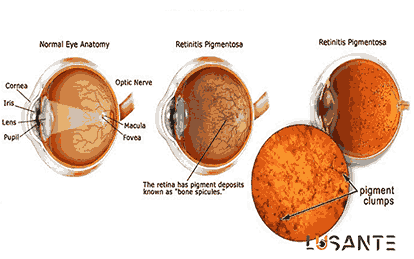
Treatment of Retinitis Pigmentosa
There is currently no specific and approved treatment for improving Retinitis Pigmentosa, but doctors are actively working to find reliable treatment methods. At present, there are options available to reduce the loss of visual function, which may even lead to partial restoration of lost vision.
Some of these approaches include:
- Stazolamide
In the advanced stages of this eye condition, small portions of the retina may become swollen. This problem is called macular edema and can result in a decrease in visual acuity. The use of this treatment helps reduce the swelling and improves vision.
- Vitamin A Palmitate
High doses of these compounds can slow down the progression of Retinitis Pigmentosa each year, but caution is advised as excessive consumption of these compounds can be dangerous and toxic. It is best to consult with your doctor and follow their recommendations when using these compounds.
- Glasses
- Wearing glasses reduces sensitivity to light.
- Glasses protect the eyes from harmful ultraviolet rays.
- Ultraviolet radiation is one of the factors that can accelerate the loss of visual acuity.
- Retinal Implants
- Retinal implants are one of the treatment options in the advanced stages.
- This surgical procedure can help regain some of the lost vision.
-
Peripheral Vision Loss and Tunnel Vision : Glaucoma
Glaucoma, refers to an increase in intraocular pressure that can cause damage to the optic nerve and result in permanent blindness.
Some types of glaucoma may have no symptoms until the advanced stages of the disease.By the time an individual becomes aware of their condition, a significant portion of their optic nerve fibers may have been lost.
This can lead to severe and irreversible vision loss. Therefore, early detection of glaucoma and timely initiation of treatment will be the key to preventing disease progression and reducing visual impairment in the patient.
In the eye, there is always a clear fluid called aqueous humor, which exits from a location called the angle (the area where the cornea meets the iris). If an obstruction or barrier occurs in the path of fluid drainage from the eye, and the aqueous humor cannot easily exit the eye, then the intraocular pressure increases.
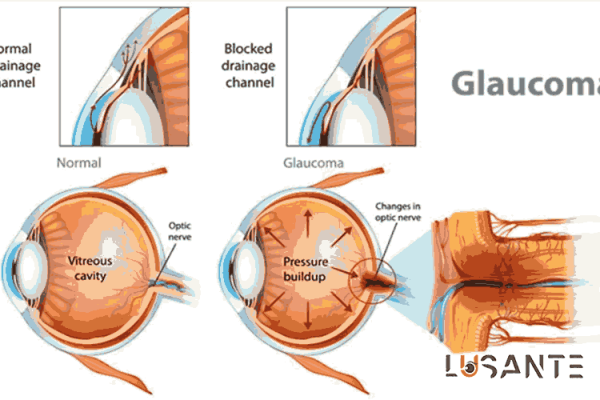
Types of glaucoma
The two main types of glaucoma are:
- Acute angle-closure glaucoma
- Chronic or primary open-angle glaucoma
Angle refers to the area inside the eye, where the cornea meets the iris, and it is the location of drainage (outflow) of aqueous fluid from the eye.
Other types of glaucoma include congenital glaucoma, pigmentary glaucoma, and secondary glaucoma (due to other eye problems).
Primary open-angle glaucoma (POAG) is the most common type of glaucoma. It gradually reduces your peripheral vision.
By the time you notice it, irreversible damage may have occurred. If high eye pressure continues (untreated), the damage continues, resulting in tunnel vision. This means you can only see objects that are right in front of you (you lose your peripheral vision).
Normal-tension glaucoma: Similar to primary open-angle glaucoma, it causes damage to the optic nerve and reduces vision, but in this condition, eye pressure is within the normal range. Since there is no pain, you may become aware of the disease only when tunnel vision has developed and irreversible damage has occurred.
The cause of this condition is unknown, but some doctors believe it is due to poor blood flow to the optic nerve. In Japanese people, it is more common in women and those with a history of vascular diseases.
Pigmentary glaucoma: This rare type occurs due to the deposition of iris pigments on the site where aqueous fluid exits the eye, causing blockage. Inflammatory responses following the closure of the channels further damage the drainage system.
Unusually, symptoms such as pain and blurred vision may occur in these individuals, especially after exercise. This condition affects mostly white-skinned men in their 30s to 40s.
Acute angle-closure glaucoma: Glaucoma with narrow or closed angles presents with symptoms such as eye pain, headaches, halos around light sources, dilated pupils, vision loss, red eyes, sudden nausea, and vomiting.
These symptoms may go away after a few hours and recur after some time. In each attack, a part of the visual field is lost.
Glaucoma can be very damaging to your vision. In fact, it is the second leading cause of blindness in the United States.
Congenital glaucoma: This hereditary type occurs at birth and is diagnosed in 80% of cases by the age of one. These children are born with narrow angles or other problems in the eye’s drainage system.
Detecting the symptoms of this disease is difficult because the children are much too young to know what is happening to them. If you notice dark, white, cloudy, or enlarged eyes in your child, consult an ophthalmologist. This condition is more common in boys than girls.
Secondary glaucoma: Glaucoma following an eye injury is called secondary glaucoma, which can be due to infection, inflammation, tumor, or a large pearl-like lesion.
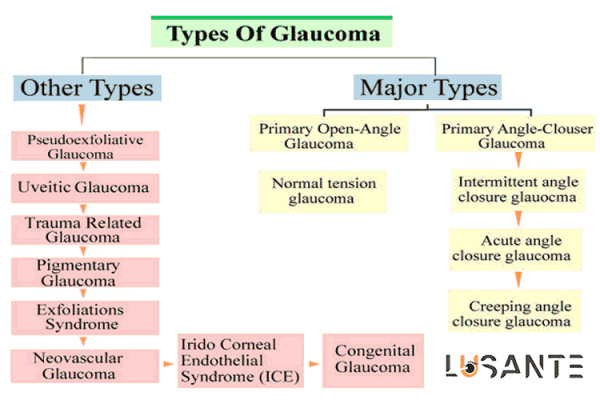
Causes of glaucoma
The cause of glaucoma is usually due to an imbalance between the production of aqueous fluid inside the eye and its outflow. The underlying reasons for this imbalance vary depending on the type of glaucoma.
Similar to how basketballs or footballs need internal air pressure to maintain their shape, the eye also requires intraocular fluid pressure to maintain its spherical shape and visual acuity.
However, glaucoma occurs when the internal eye structures are unable to control intraocular pressure, and the eye pressure becomes dangerously high. Unlike balls that can release pressure by increasing elasticity and deflating through a hole, the eye cannot relieve increased pressure in the same way.
Instead, the high pressure persists, exerting pressure on the optic nerve and causing permanent damage to it, leading to blindness.
Glaucoma and the Eye Structure
To understand why glaucoma occurs, you need to know some facts about the eye’s structure and how fluids move within the eye.
The fluid inside the eye is produced by the ciliary body, which are small circular structures located behind the iris of the eye.
This fluid, called aqueous humor, flows from behind the iris and through the pupil or the central hole of the iris, filling the anterior chamber, the space between the back of the cornea and the front of the iris.
The aqueous humor is drained from the eye through a structure called the trabecular meshwork, which is located in the angle between the iris and the cornea.
From there, the aqueous humor is filtered between this angle and the sclera (the white part of the eye) and then exits the eye through the eye’s vascular system. Any disruption in the flow of the aqueous humor can lead to an increase in intraocular pressure.
Depending on the size of this angle, it can be classified as open-angle or narrow-angle glaucoma. A narrow angle makes it more challenging for the aqueous humor to pass through it. An open angle can also cause delays in the drainage of aqueous humor if there are structural issues with the angle inside the eye.
Glaucoma, Blood Flow, and Optic Nerve Damage
Although increased intraocular pressure is often associated with glaucoma, the disease can occur even when the pressure inside the eye is within the normal range (normal-tension glaucoma). Individuals with this condition have heightened sensitivity of their optic nerve to slight increases in intraocular pressure, leading to irreversible optic nerve damage even at near-normal pressure levels.
On the other hand, some individuals with high-normal pressure may never experience glaucoma. The most common traditional method for diagnosing glaucoma is measuring intraocular pressure, but since glaucoma with normal-tension can also exist, a direct examination of the optic nerve and visual field testing or other measures may be necessary for diagnosis.
In normal-tension glaucoma, one theory suggests that reduced blood flow to the optic nerve may be the cause of the problem. Reduced blood flow could contribute to optic nerve damage alongside increased intraocular pressure.
Some studies have shown that decreased blood flow is associated with the development of blind spots (scotomas) that are seen in visual field defects associated with glaucoma.
In an intriguing study published in August 2007, a potential link between glaucoma and Alzheimer’s disease, which leads to memory loss due to brain damage, was suggested.
London-based researchers found that certain protein structures called beta-amyloids found in the retina and brain tissues are implicated in both glaucoma and Alzheimer’s.
However, the abnormal accumulation of beta-amyloid proteins does not necessarily mean that everyone with Alzheimer’s will develop glaucoma, or vice versa.
The researchers theorize that the structural similarity between the brain and the retina may explain why the beta-amyloid protein affects both organs.
Additionally, glaucoma has recently been associated with protecting retinal nerve cells from damage.

Primary Open-Angle Glaucoma (P-OAG)
In Primary Open-Angle Glaucoma (P-OAG), the aqueous humor, located in the anterior chamber between the cornea and the iris (the colored part of the eye), cannot exit from the drainage angle (the angle of the eye) where it needs to leave. This is because the drainage channels (trabecular meshwork) are obstructed, leading to elevated eye pressure.
Increased intraocular pressure exerts pressure on the optic nerve fibers responsible for transmitting images to the brain. This pressure increase reduces the blood flow to the optic nerve, depriving it of oxygen and nutrients. Moreover, elevated intraocular pressure can cause irreversible damage to the optic nerve, leading to blindness.
Risk factors for Chronic Open-Angle Glaucoma include:
- Age: The risk of developing this disease increases with age, especially after the age of forty, and the risk continues to rise with every ten years. Aging can also lead to wrinkling and thinning of the trabecular meshwork (the location of aqueous humor drainage), resulting in reduced aqueous outflow.
- Medical conditions: Diabetes, very high myopia (nearsightedness), and a history of previous eye surgeries are risk factors for Chronic Open-Angle Glaucoma. Prolonged and significant use of steroid inhalers can also increase the risk of this disease. Other factors that may elevate the risk of glaucoma include migraines, high blood pressure, narrow blood vessels (vasospasm), and cardiovascular diseases.
- Structural eye disorders: Structural abnormalities within the eye can lead to glaucoma. Pseudoexfoliation syndrome can cause proteins from the natural lens, iris, and other eye structures to peel off and block the eye’s drainage system. Additionally, if the iris undergoes changes in shape that lead to blockage of the drainage site, it can cause Chronic Open-Angle Glaucoma.
- Ethnicity: Chronic Open-Angle Glaucoma is more common in African-Americans compared to Caucasians. Additionally, this ethnicity is more susceptible to the severe form of glaucoma that affects younger individuals.
- Family history: The risk of developing this disease is three to four times higher if one or more parents or siblings have the condition.
To Grading Glaucoma, Add up the numerical values to determine your risk level. Grade 4 and higher indicate high risk, grade 3 suggests moderate risk, grade 2 or less indicates low risk.
Chronic Open-Angle Glaucoma gradually reduces peripheral vision. However, by the time it becomes noticeable, it may have already caused irreversible damage.
If elevated eye pressure persists, it continues to damage the peripheral vision to the point where an individual can only see objects directly in front of them.
Like other types of glaucoma, treatment options may include eye drops alone or laser and non-laser surgeries to control intraocular pressure.
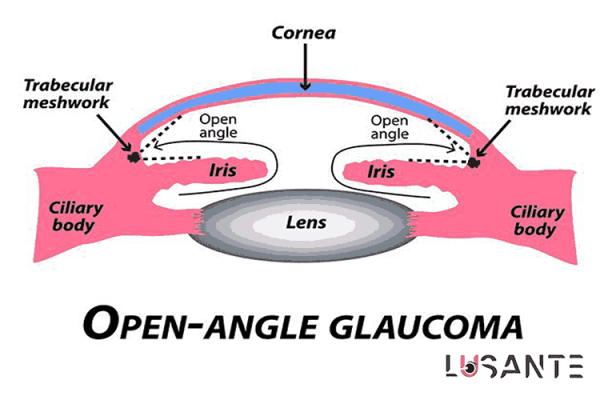
Narrow-Angle Glaucoma
Narrow-Angle Glaucoma occurs acutely when the iris (the colored part of the eye) is pushed or pulled forward, leading to the closure of the drainage angle. This hinders the exit of aqueous humor where the trabecular meshwork allows its drainage.
When the internal structure of the eye closes in this manner, the intraocular pressure may suddenly increase, causing damage to the optic nerve.
Narrow-Angle Glaucoma, also known as acute closed-angle glaucoma, presents symptoms such as eye pain, headache, halos around lights, dilated pupils, vision loss, redness in the eyes, nausea, and vomiting.
These symptoms may persist for hours or until the intraocular pressure is reduced. Each attack of Narrow-Angle Glaucoma can lead to the loss of a portion of the visual field. This condition is considered a medical emergency, as if high pressure is not reduced for hours, permanent vision loss may occur.
Anyone experiencing these symptoms should immediately seek an eye specialist or visit an emergency center. Some cases of Narrow-Angle Glaucoma can be chronic and progress slowly, causing damage to vision without pain or discomfort.
Causes of Narrow or Closed-Angle Glaucoma
The abnormal positioning of the iris in this condition can be caused by the following factors:
- Pupillary block: Aqueous humor is produced by the ciliary body located behind the iris. Normally, this fluid flows from behind the iris to the anterior chamber in front of the iris. However, if the iris sticks to the lens of the eye, it blocks the path of the aqueous humor. As a result, the fluid backs up, accumulates behind the iris, and causes pressure to build up in front of it, leading to the closure of the drainage angle in the anterior chamber.
- Forward displacement of the iris: In this condition, the iris is positioned closer to the trabecular meshwork, where drainage occurs. When the pupil dilates, the peripheral iris tissue covers the drainage angle, causing a sudden increase in intraocular pressure. Attacks in this type of glaucoma may occur when the person is in low light conditions or when mydriatic eye drops are used for eye examination.
- Hyperopia: Individuals with hyperopia are more susceptible to having a narrower angle and a shallower anterior chamber. The risk of developing Narrow-Angle Glaucoma increases with the opening of the pupil and with age-related changes.
- Tumors or masses (ocular or non-ocular diseases): A tumor behind the iris, swelling of the ciliary body following intermediate uveitis (intraocular inflammation), and changes in the eye’s shape after retinal detachment surgery can also cause Narrow-Angle Glaucoma.
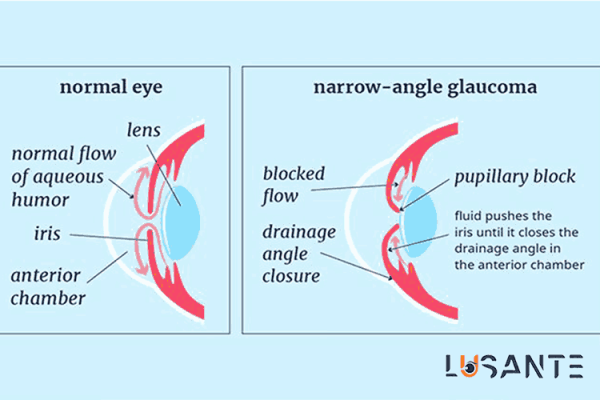
4. Peripheral Vision Loss and Tunnel Vision:
Diabetic Retinopathy
Diabetic retinopathy is a disease that can cause Peripheral Vision Loss, tunnel vision and vision loss in diabetic individuals.
NEI (National Eye Institute) reminds us that individuals with high blood sugar levels can experience damage to the retina of the eye.
The retina is a part of the eye that detects light and sends signals through the optic nerve to the brain.
Diabetic retinopathy usually doesn’t have any symptoms in the early stages. As mentioned, there may be subtle changes in vision, such as difficulty seeing objects or reading.
However, in later stages, with the onset of retinal hemorrhage, individuals may observe dark, floating spots. Spiderweb-like veins may also appear in their vision.
Realted Article: Which Supplement Helps to Prevent Diabetes And Vision loss? | 5 Certain Method To Reduce







